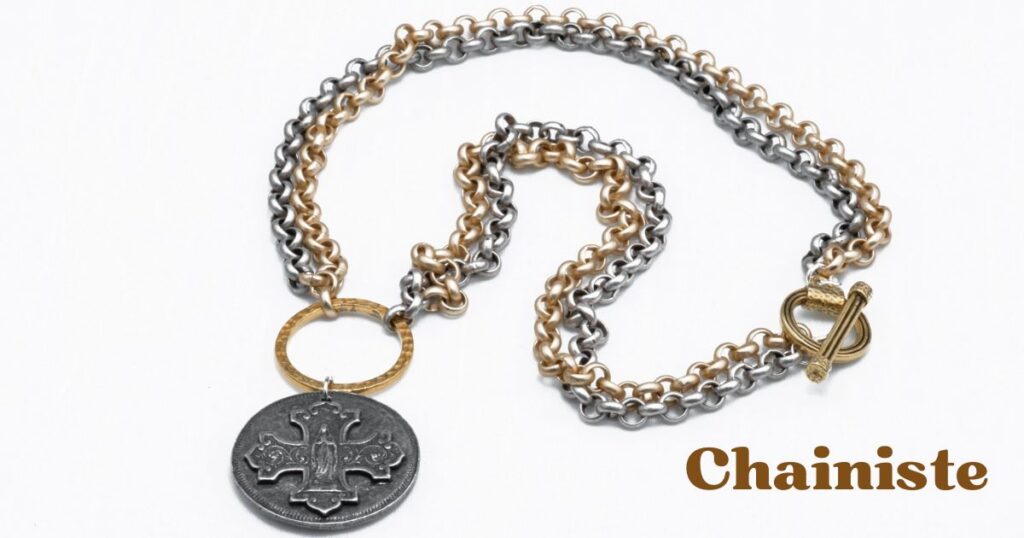A chainiste is a skilled artisan who specializes in crafting metal chains. These experts work with precious metals like gold, silver, and platinum to create intricate, durable links. Their creations range from delicate jewelry to robust industrial components, showcasing a blend of technical skill and artistic vision.
“The Art of the Chain: Exploring the World of the chainiste” captures the essence of this ancient yet evolving craft. Imagine a world where each link tells a story, where tradition meets innovation in a dance of metal and creativity. This is the realm of the chainiste, where precision and passion intertwine to create wearable art and functional marvels.
Chainistes shape our world in ways both seen and unseen. Their work adorns necks and wrists, secures eyeglasses, and powers industries. With roots stretching back centuries, these artisans continue to push boundaries, embracing new technologies while preserving time-honored techniques. The chainiste’s craft is a testament to human ingenuity and the enduring allure of handmade excellence.
A Historical Craft Steeped in Tradition
Imagine walking through ancient Egypt or Mesopotamia and spotting someone wearing a beautifully crafted chain. Yep, chainmaking goes back that far! This art has been around for ages, with each culture adding its own flair.
But it was in 17th century France, especially in Besançon, where chainmaking really hit its stride. These French artisans, known as chainistes, became the rockstars of the metal world, creating chains so stunning they were practically celebrity accessories.
The Enduring Legacy of the chainiste
Fast forward to today, and chainistes are still going strong. Sure, machines can crank out chains by the truckload, but there’s something special about a handcrafted piece. Modern chainistes blend old-school techniques with new tech, creating everything from delicate necklaces to massive sculptures.
They’re not just stuck in jewelry either; you’ll find their work in fashion, eyewear, and even heavy industry. What’s really cool is how they’re keeping the craft alive while pushing its boundaries. They’re like metal magicians, turning simple chains into works of art that connect us to centuries of human creativity. In a world of mass-produced stuff, the chainiste’s touch adds a bit of magic and history to whatever they create.
Recommended Blog: Signs of Unhealthy Locs: Tips for Dreadlocks Care & Repair
The Process: From Metal to Masterpiece
Have you thought about how a simple metal can turn into such an exquisite chain? Well, let us tear the veil and I’ll show you how the chainistes operate.
Material Selection:
First things first – choosing the right metal. It’s like picking the perfect ingredient for a recipe. Chainistes have a whole buffet of options: gold for that classic bling, silver for a cool, sleek look, or platinum if you’re feeling fancy. But it’s not just about looks. They think about stuff like how strong the chain needs to be or how heavy it should feel.
Sometimes they even use less flashy metals like brass or stainless steel. It all depends on what the final chain is for – a delicate necklace needs different stuff than a heavy-duty industrial chain.
Wire Drawing:
Once they’ve got their metal, it’s time to make it skinny. The chainiste pulls the metal through tiny holes (called dies) over and over. Each time, the wire gets thinner and longer. It’s kind of like when you roll out dough, but way more precise. They keep at it until the wire is just the right thickness for the links they want to make.
Joining the Links:
Now comes the tricky part – turning that wire into actual chain links and hooking them all together. This is where the chainiste’s skills really shine. They might use special tools to bend the wire into perfect little loops, or they might go old school and do it by hand.
Then they’ve got to connect all those links. Some use tiny soldering tools to fuse the metal, while others use jump rings (little metal circles) to link everything together. It’s fiddly work that takes a steady hand and a ton of patience.
Finishing Touches:
Last but not least, it’s time to make that chain shine! The chainiste polishes the metal until it gleams, bringing out all its natural beauty. They might give it a special finish too – maybe a high shine for that mirror-like look, or a brushed finish for something more subtle. It’s these final touches that really make the chain pop and turn it from a bunch of metal links into a true work of art.
Beyond Traditional Techniques: Embracing Innovation
Chainistes love their old-school methods, but they’re not stuck in the past. These days, they’re all about mixing the old with the new. Picture this: a master craftsman using a laser cutter to create super intricate designs that would’ve been impossible by hand. Or imagine using 3D printing to prototype a chain before diving into the metal work. It’s like giving traditional chain-making a high-tech makeover!
Some chainistes are even playing around with computer programs to design wild, mind-bending patterns. And it’s not just about looks; these new techniques can make chains stronger, lighter, and more durable than ever. It’s pretty cool how they’re keeping the soul of the craft alive while giving it a modern twist.
Recommended Blog: Mexican Edgar Cut Ideas for Men
The Versatility of Chain making: Beyond Jewelry
Chainmaking isn’t just about creating beautiful necklaces and bracelets. These skilled artisans, known as chainistes, craft intricate metal links that find their way into many aspects of our lives. Their expertise extends far beyond the jewelry box, touching industries you might not expect.
Fashion:
In the world of haute couture and everyday style, chains add a touch of glamour and functionality. Designers incorporate delicate chains into clothing as eye-catching accents or use sturdier versions to create statement pieces. Handbags often feature chain straps, blending durability with elegance. Even shoes and belts can benefit from a chainiste’s craft, adding a unique flair to accessories.
Eyewear:
Glasses wearers know the frustration of misplacing their specs. Enter the chainiste’s solution: elegant eyeglass chains. These functional pieces keep glasses secure while doubling as a fashionable accessory. From subtle, thin chains to bold, decorative ones, they offer both style and practicality.
Industrial Applications:
The skills of a chainiste shine in unexpected places. Industries rely on specialized chains for various tasks. Think of conveyor belts in factories, timing chains in car engines, or robust chains used in construction and shipping. These chains require precision, strength, and reliability, all hallmarks of a skilled chainiste’s work.
A Glimpse into the Future of Chain-Making
The art of chain-making is evolving, blending time-honored techniques with cutting-edge technology. As we look ahead, we can expect to see chainistes pushing the boundaries of their craft. Advanced tools like 3D printers and laser cutters are opening up new possibilities for intricate designs that were once impossible to create by hand. These innovations allow for more precise, complex patterns and the use of unconventional materials.
Despite these technological advancements, the human touch remains irreplaceable. The future of chain-making will likely see a harmonious blend of traditional skills and modern methods, resulting in pieces that are both innovative and soul-stirring.
The Enduring Allure of the Chainiste
In a world dominated by mass production, the chainiste stands as a beacon of craftsmanship and individuality. These skilled artisans continue to captivate us with their ability to transform simple metal into works of art. Each chain tells a story – of tradition, skill, and creativity.
The allure of handcrafted chains lies in their uniqueness. No two pieces are exactly alike, each bearing the subtle marks of its creator. This human element resonates with those seeking authenticity in an increasingly automated world. As we move forward, the chainiste’s craft serves as a reminder of the enduring value of human skill and artistry, ensuring that this ancient profession will continue to thrive and inspire for generations to come.
In conclusion
The world of chainistes is a fascinating blend of tradition and innovation. These skilled artisans create more than just jewelry; their work touches various industries and aspects of our lives. From fashion to industrial applications, the versatility of chain-making is truly remarkable.
As we look to the future, the craft continues to evolve, embracing new technologies while preserving timeless techniques. The enduring allure of handcrafted chains reminds us of the irreplaceable value of human skill and creativity in our increasingly automated world.



